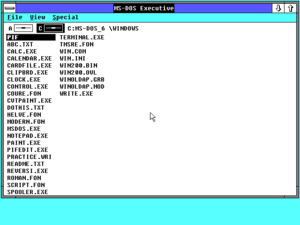Windows 2.0
| A version of the Microsoft Windows operating system | |
|
| |
|
Screenshot of Windows 2.0 | |
| Developer | Microsoft |
|---|---|
| Source model | Closed source |
| Released to manufacturing | December 9, 1987 |
| License | Commercial software |
| Preceded by | Windows 1.0 (1985) |
| Succeeded by | Windows 2.1x (1988) |
| Official website | http://www.microsoft.com/ |
| Support status | |
| Unsupported as of December 31, 2001 | |
Windows 2.0 is a 16-bit Microsoft Windows GUI-based operating environment that was released on December 9, 1987,[1] and is the successor to Windows 1.0.
Features
Windows 2.0 allowed application windows to overlap each other unlike its predecessor Windows 1.0, which could display only tiled windows.[2] Windows 2.0 also introduced more sophisticated keyboard-shortcuts[3] and the terminology of "Minimize" and "Maximize", as opposed to "Iconize" and "Zoom" in Windows 1.0.[4] The basic window setup introduced here would last through Windows 3.1. Like Windows 1.x, Windows 2.x applications cannot be run on Windows 3.1 or up without modifications since they were not designed for protected mode.[5] Windows 2.0 was also the first Windows version to integrate the control panel.[2]
New features in Windows 2.0 included VGA graphics (although 16 colors only). It was also the last version of Windows that did not require a hard disk. With the improved speed, reliability and usability, computers now started becoming a part of daily life for some workers. Desktop icons and use of keyboard shortcuts helped to speed up the work.[6] The Windows 2.x EGA, VGA, and Tandy drivers notably provided a workaround in Windows 3.0 for users who wanted color graphics on 8086 machines (a feature that version normally did not support). EMS memory support also appeared for the first time.[7]
Application support
The first Windows versions of Microsoft Word and Microsoft Excel ran on Windows 2.0.[2] Third-party developer support for Windows increased substantially with this version (some shipped the Windows Runtime software with their applications, for customers who had not purchased the full version of Windows).[4] However, most developers still maintained DOS versions of their applications,[2] as Windows users were still a distinct minority of their market. Windows 2.0 was still very dependent on the DOS system and it still hadn't passed the 1 megabyte mark in terms of memory.[8]
There were some applications that shipped with Windows 2.0. They are:
- CALC.EXE – a calculator[9]
- CALENDAR.EXE – calendaring software[9]
- CARDFILE.EXE – a personal information manager[9]
- CLIPBRD.EXE – software for viewing the contents of the clipboard[9]
- CLOCK.EXE – a clock[9]
- CONTROL.EXE – the system utility responsible for configuring Windows 2.0[9]
- CVTPAINT.EXE - Converted paint files to the 2.x format[10]
- MSDOS.EXE – a simple file manager[9]
- NOTEPAD.EXE – a text editor[9]
- PAINT.EXE – a raster graphics editor that allows users to paint and edit pictures interactively on the computer screen[9]
- PIFEDIT.EXE – a program information file editor that defines how a DOS program should behave inside Windows
- REVERSI.EXE – a computer game of reversi[9]
- SPOOLER.EXE – the print spooler of Windows, a program that manages and maintains a queue of documents to be printed, sending them to the printer as soon as the printer is ready[9]
- TERMINAL.EXE – a terminal emulator[9]
- WRITE.EXE – a simple word processor[9]
Legal conflict with Apple
On March 17, 1988, Apple Inc. filed a lawsuit against Microsoft and Hewlett-Packard, accusing them of violating copyrights Apple held on the Macintosh System Software.[11] Apple claimed the "look and feel" of the Macintosh operating system, taken as a whole, was protected by copyright and that Windows 2.0 violated this copyright by having the same icons. The judge ruled in favor of Hewlett-Packard and Microsoft in all but 10 of the 189 patents that Apple sued for. The exclusive 10 could not be copyrighted, as ruled by the judge.[2]
References
- ↑ "A History of Windows". Microsoft. Microsoft. 2012. Archived from the original on 10 June 2016.
- 1 2 3 4 5 "History of Microsoft". Chip.eu Download. Chip.eu. February 7, 2012. Retrieved August 7, 2013.
- ↑ "The History of Microsoft Windows operating systems". Webopedia. Webopedia. January 27, 2012. Retrieved August 7, 2013.
- 1 2 "Windows 2.0". SBP Romania. SBP Romania. 2013. Retrieved August 7, 2013.
- ↑ Tim Robinson (August 26, 2002). "Virtual 8086 Mode". osdev.berlios.de. OSDev. Retrieved August 7, 2013.
- ↑ Mahesh Dabade (November 21, 2015). "History of Windows Operating System". TechTrickle. TechTrickle. Retrieved November 21, 2015.
- ↑ Seth Sibangan (August 7, 2013). "Kellys". SlideShare. Seth Sibangan. Retrieved August 7, 2013.
- ↑ "Windows 2.0 definition". The Free Dictionary. The Free Dictionary. Retrieved August 7, 2013.
- 1 2 3 4 5 6 7 8 9 10 11 12 13 "Windows 2.03". Toasty Tech. Toasty Tech. Retrieved August 7, 2013.
- ↑ "Windows Version History". Microsoft Support. Microsoft. Retrieved July 14, 2013.
- ↑ "1980 - 1989: An Industrial Milestone". The Apple Museum. Retrieved September 4, 2009.
External links
- GUIdebook: Windows 2.0 Gallery – A website dedicated to preserving and showcasing Graphical User Interfaces
- ComputerHope.com: Microsoft Windows history
- Microsoft article with details about the different versions of Windows

.svg.png)